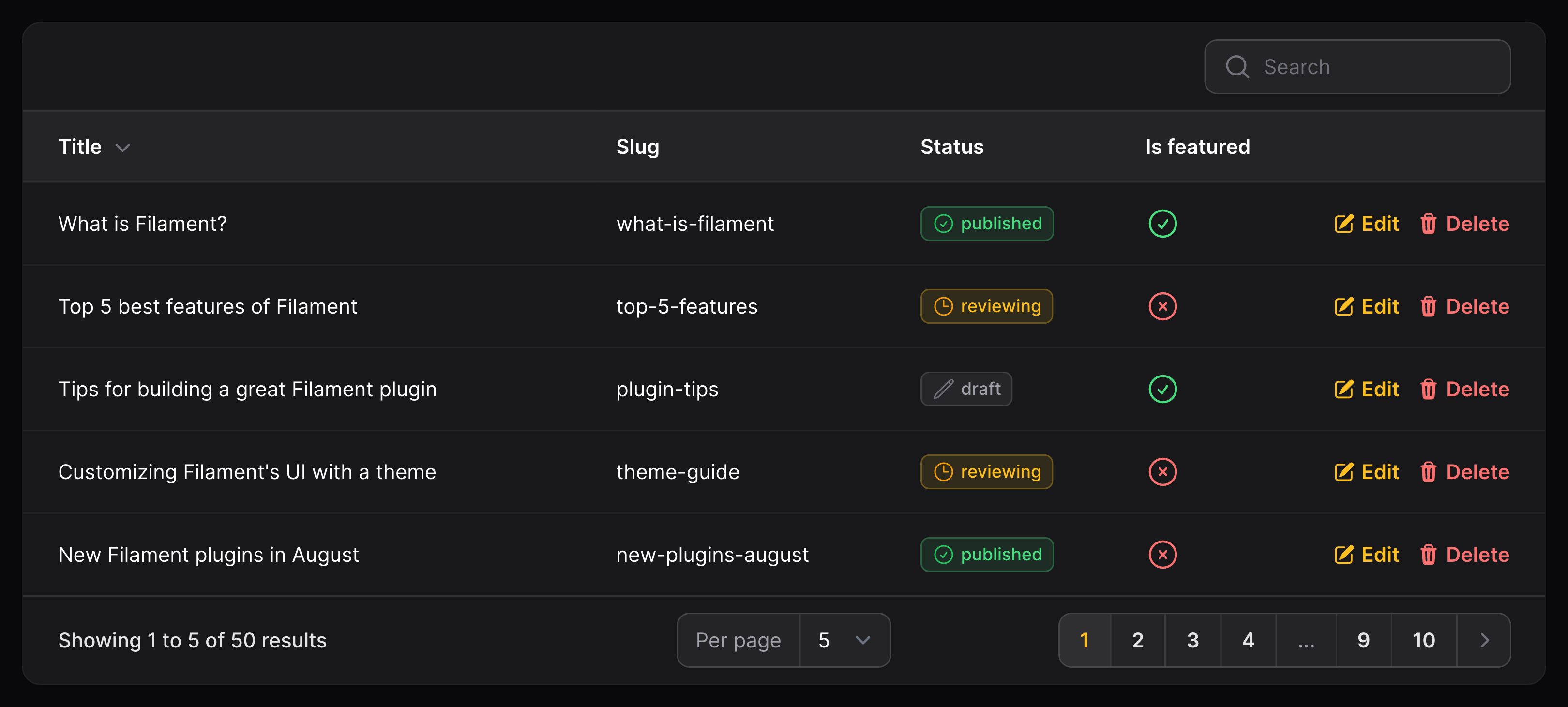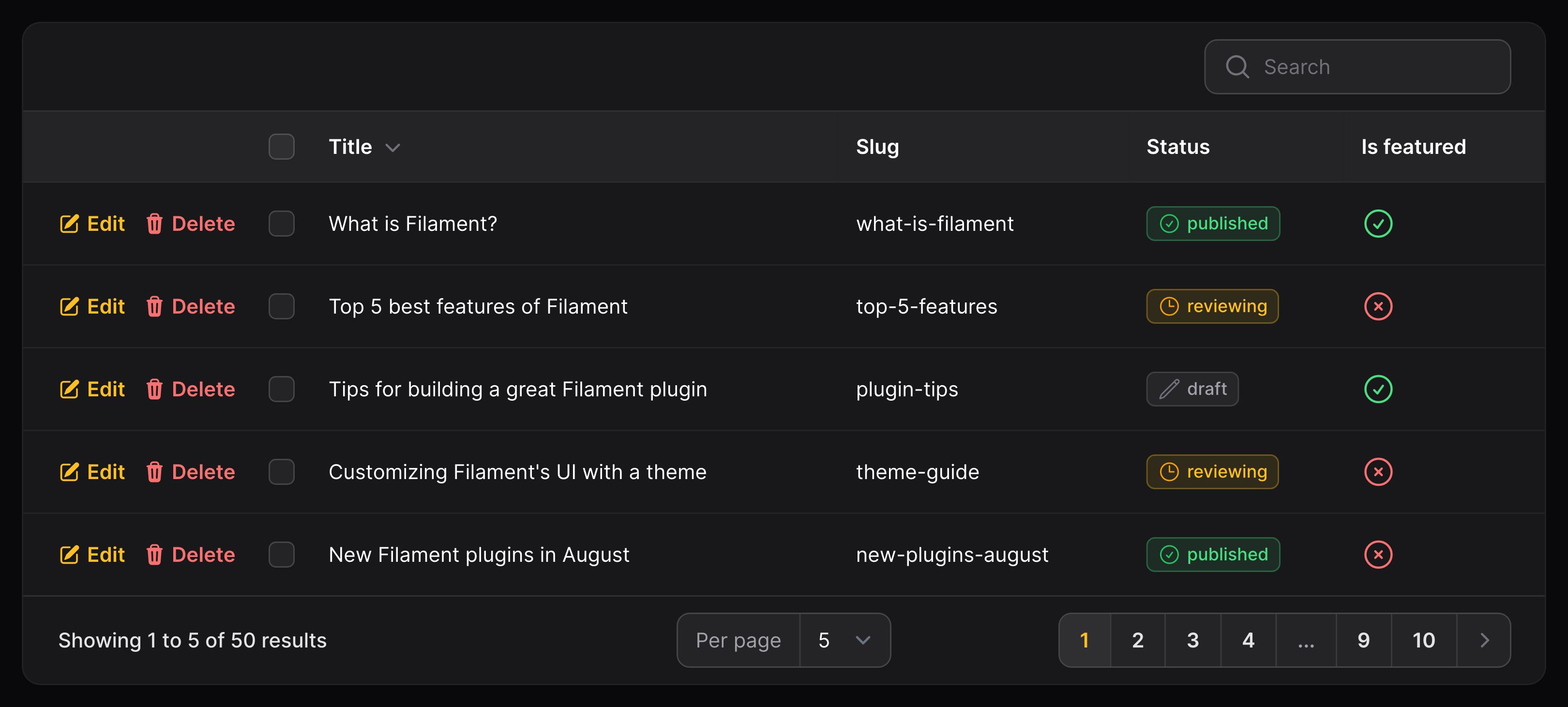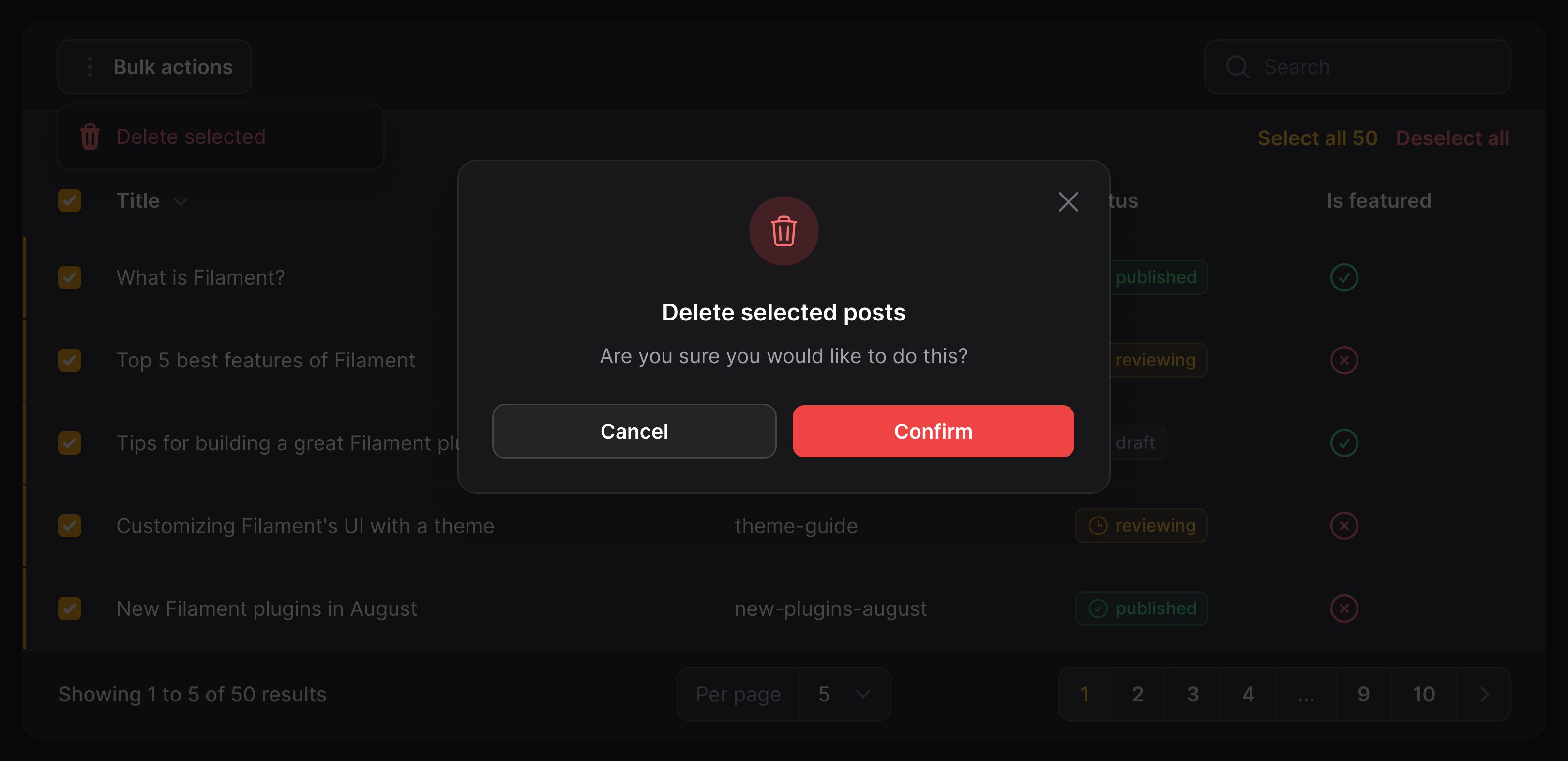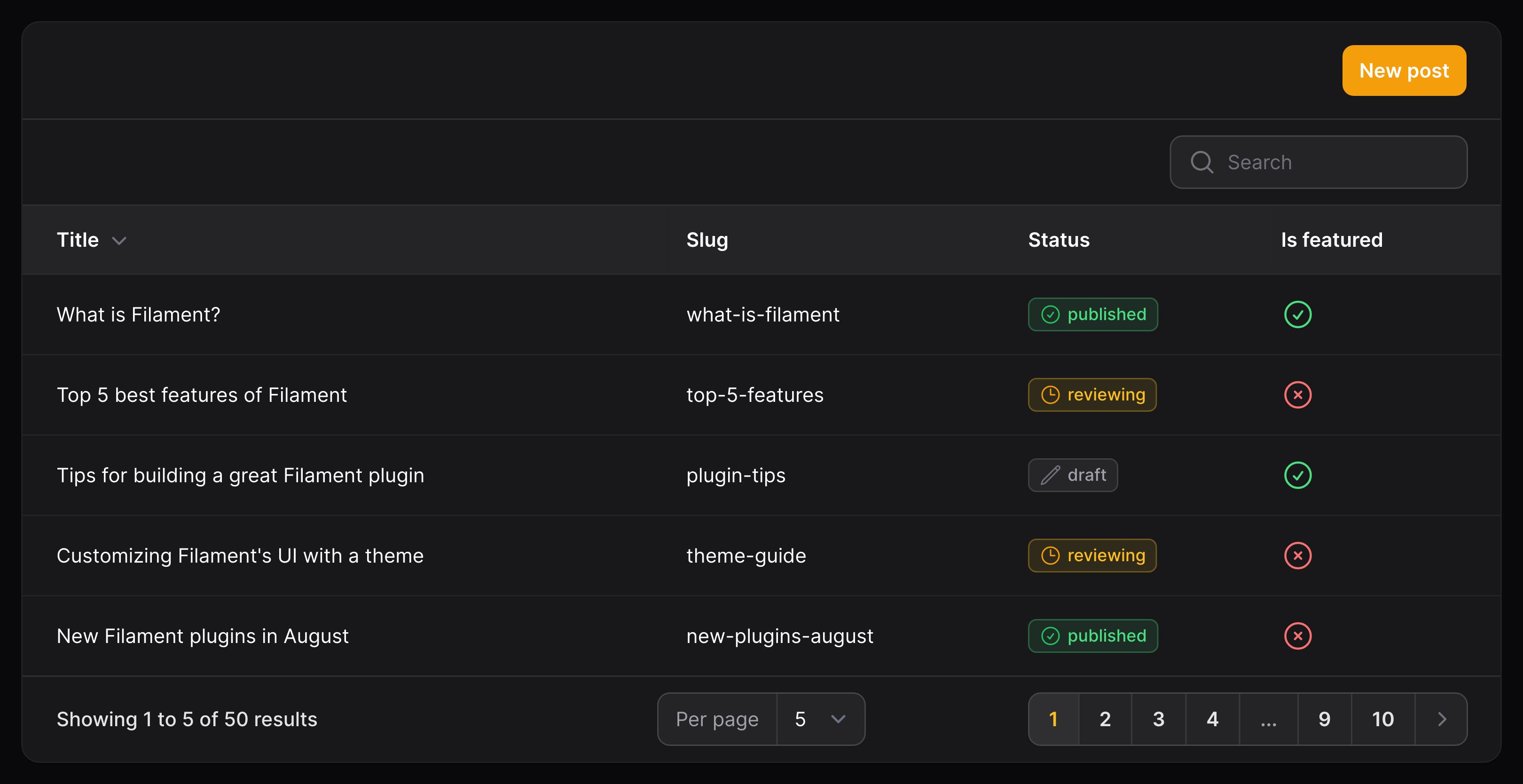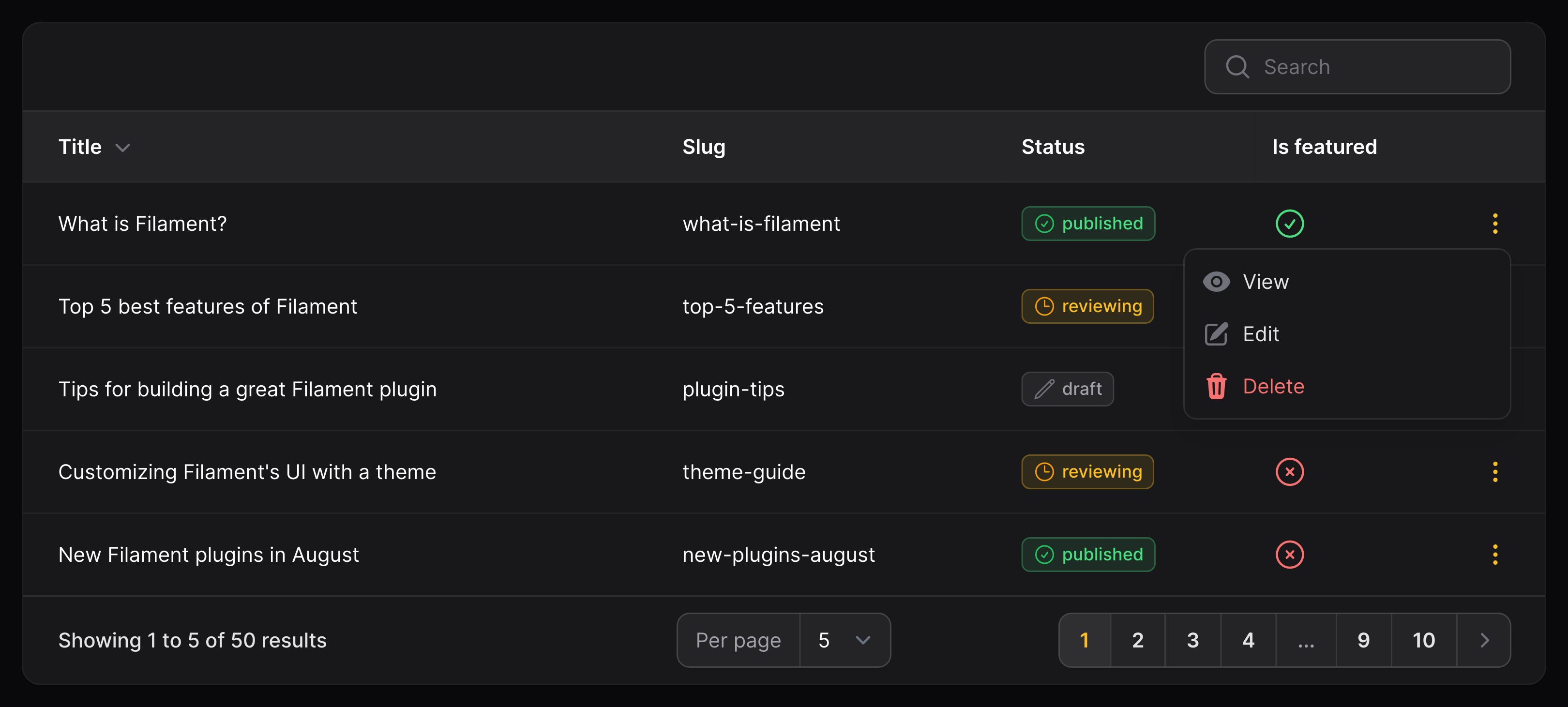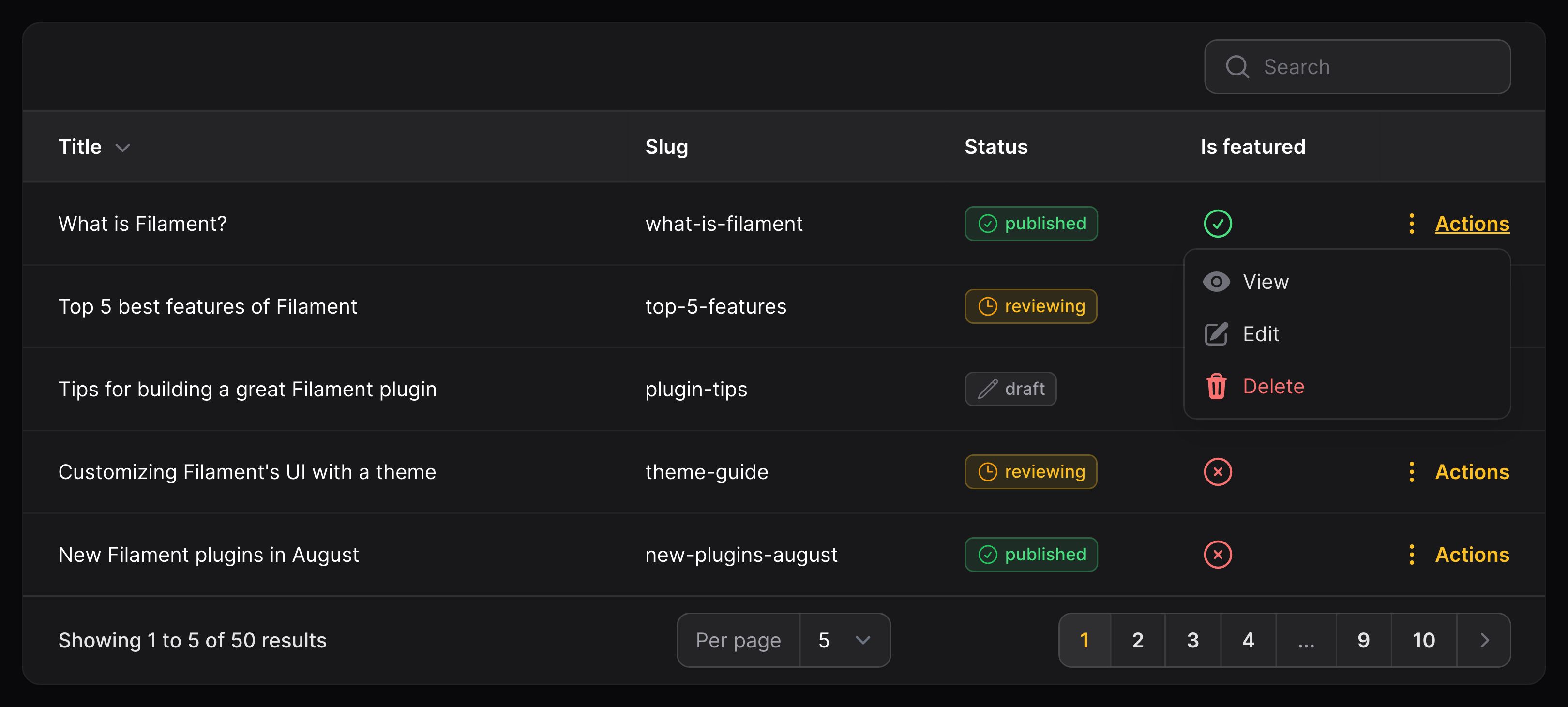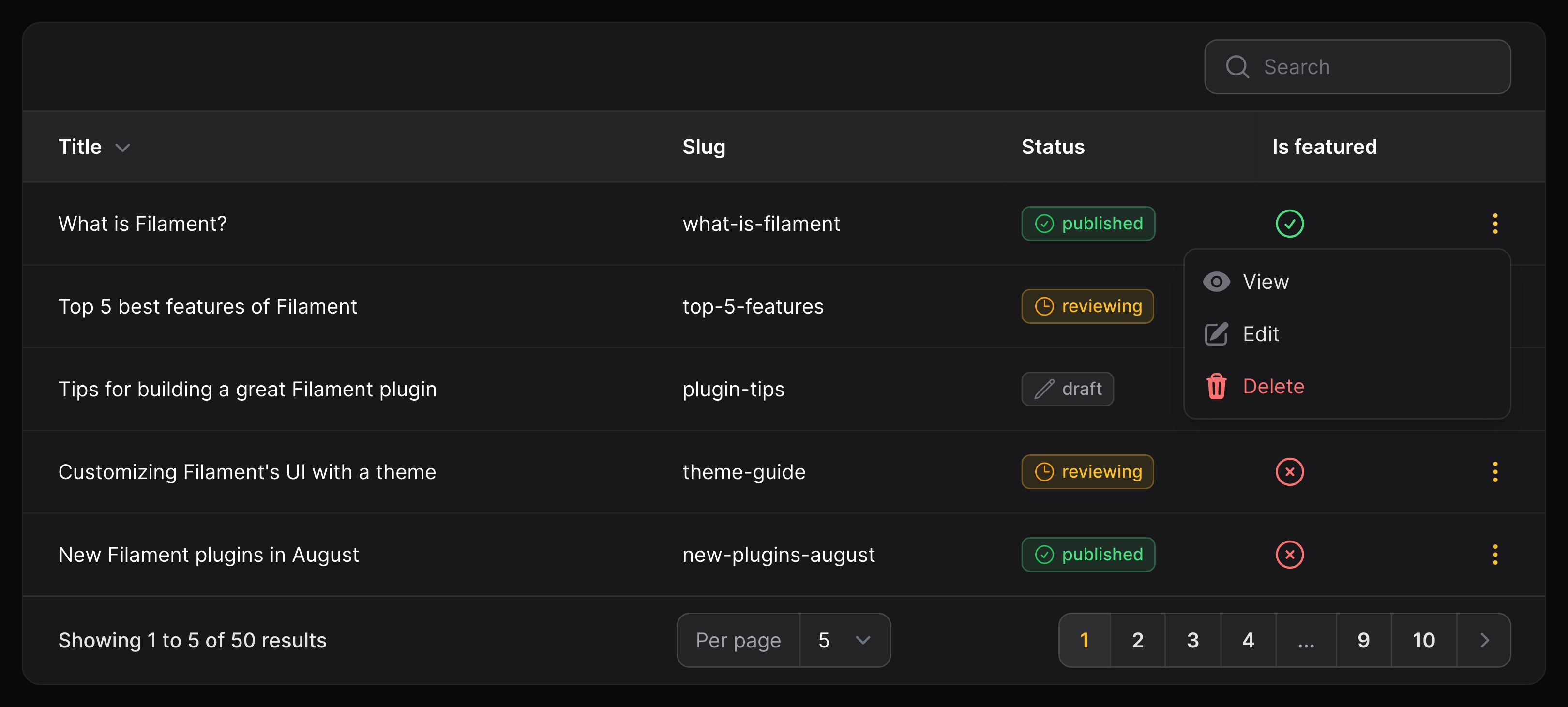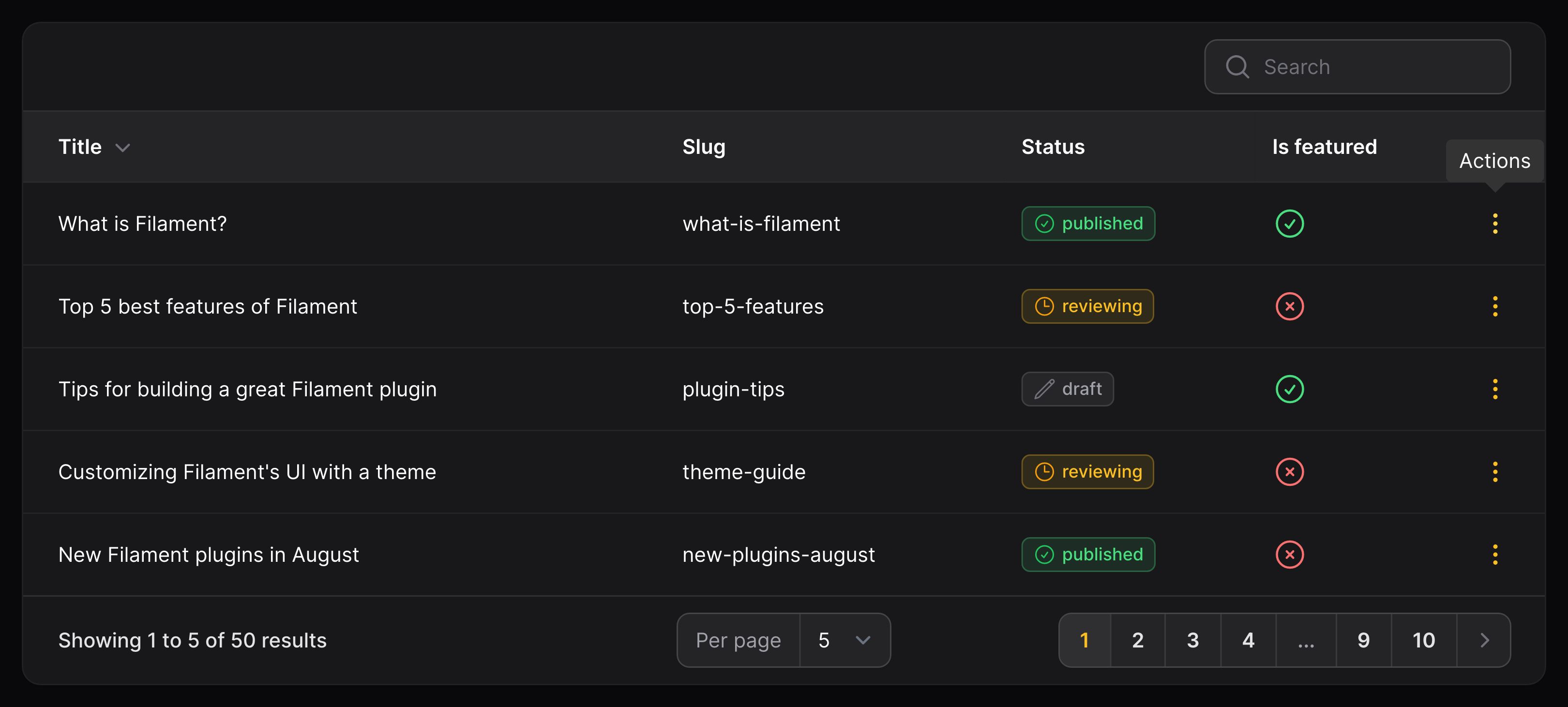Actions
Overview
Filament's tables can use Actions. They are buttons that can be added to the end of any table row, or even in the header of a table. For instance, you may want an action to "create" a new record in the header, and then "edit" and "delete" actions on each row. Bulk actions can be used to execute code when records in the table are selected. Additionally, actions can be added to any table column, such that each cell in that column is a trigger for your action.
It's highly advised that you read the documentation about customizing action trigger buttons and action modals to that you are aware of the full capabilities of actions.
Row actions
Action buttons can be rendered at the end of each table row. You can put them in the $table->actions() method:
use Filament\Tables\Table;
public function table(Table $table): Table
{
return $table
->actions([
// ...
]);
}
Actions may be created using the static make() method, passing its unique name.
You can then pass a function to action() which executes the task, or a function to url() which creates a link:
use App\Models\Post;
use Filament\Tables\Actions\Action;
Action::make('edit')
->url(fn (Post $record): string => route('posts.edit', $record))
->openUrlInNewTab()
Action::make('delete')
->requiresConfirmation()
->action(fn (Post $record) => $record->delete())
All methods on the action accept callback functions, where you can access the current table $record that was clicked.

Positioning row actions before columns
By default, the row actions in your table are rendered in the final cell of each row. You may move them before the columns by using the position argument:
use Filament\Tables\Enums\ActionsPosition;
use Filament\Tables\Table;
public function table(Table $table): Table
{
return $table
->actions([
// ...
], position: ActionsPosition::BeforeColumns);
}
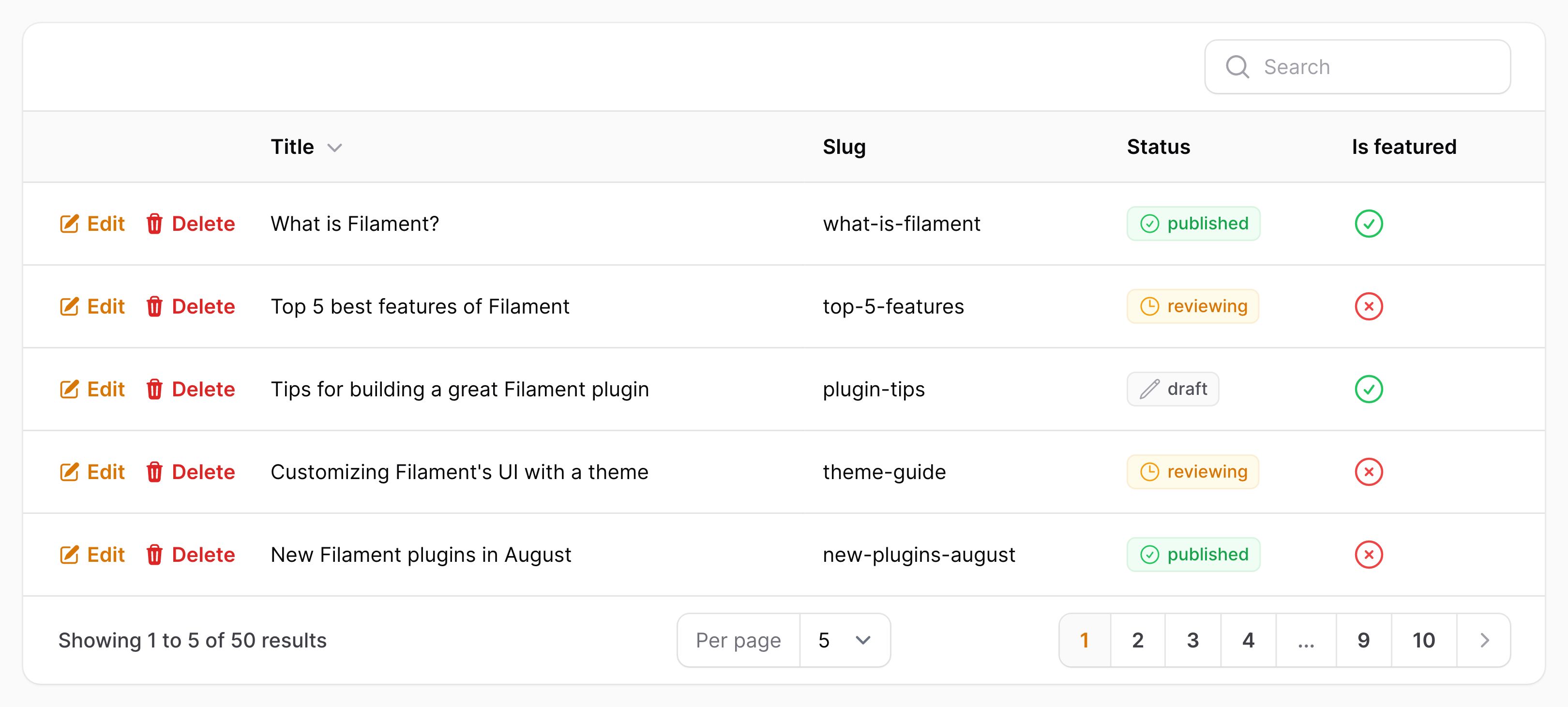
Positioning row actions before the checkbox column
By default, the row actions in your table are rendered in the final cell of each row. You may move them before the checkbox column by using the position argument:
use Filament\Tables\Enums\ActionsPosition;
use Filament\Tables\Table;
public function table(Table $table): Table
{
return $table
->actions([
// ...
], position: ActionsPosition::BeforeCells);
}

Accessing the selected table rows
You may want an action to be able to access all the selected rows in the table. Usually, this is done with a bulk action in the header of the table. However, you may want to do this with a row action, where the selected rows provide context for the action.
For example, you may want to have a row action that copies the row data to all the selected records. To force the table to be selectable, even if there aren't bulk actions defined, you need to use the selectable() method. To allow the action to access the selected records, you need to use the accessSelectedRecords() method. Then, you can use the $selectedRecords parameter in your action to access the selected records:
use Filament\Tables\Table;
use Filament\Tables\Actions\Action;
use Illuminate\Database\Eloquent\Collection;
use Illuminate\Database\Eloquent\Model;
public function table(Table $table): Table
{
return $table
->selectable()
->actions([
Action::make('copyToSelected')
->accessSelectedRecords()
->action(function (Model $record, Collection $selectedRecords) {
$selectedRecords->each(
fn (Model $selectedRecord) => $selectedRecord->update([
'is_active' => $record->is_active,
]),
);
}),
]);
}
Bulk actions
Tables also support "bulk actions". These can be used when the user selects rows in the table. Traditionally, when rows are selected, a "bulk actions" button appears in the top left corner of the table. When the user clicks this button, they are presented with a dropdown menu of actions to choose from. You can put them in the $table->bulkActions() method:
use Filament\Tables\Table;
public function table(Table $table): Table
{
return $table
->bulkActions([
// ...
]);
}
Bulk actions may be created using the static make() method, passing its unique name. You should then pass a callback to action() which executes the task:
use Filament\Tables\Actions\BulkAction;
use Illuminate\Database\Eloquent\Collection;
BulkAction::make('delete')
->requiresConfirmation()
->action(fn (Collection $records) => $records->each->delete())
The function allows you to access the current table $records that are selected. It is an Eloquent collection of models.

Grouping bulk actions
You may use a BulkActionGroup object to group multiple bulk actions together in a dropdown. Any bulk actions that remain outside the BulkActionGroup will be rendered next to the dropdown's trigger button:
use Filament\Tables\Actions\BulkAction;
use Filament\Tables\Actions\BulkActionGroup;
use Filament\Tables\Table;
public function table(Table $table): Table
{
return $table
->bulkActions([
BulkActionGroup::make([
BulkAction::make('delete')
->requiresConfirmation()
->action(fn (Collection $records) => $records->each->delete()),
BulkAction::make('forceDelete')
->requiresConfirmation()
->action(fn (Collection $records) => $records->each->forceDelete()),
]),
BulkAction::make('export')->button()->action(fn (Collection $records) => ...),
]);
}
Alternatively, if all of your bulk actions are grouped, you can use the shorthand groupedBulkActions() method:
use Filament\Tables\Actions\BulkAction;
use Filament\Tables\Actions\BulkActionGroup;
use Filament\Tables\Table;
public function table(Table $table): Table
{
return $table
->groupedBulkActions([
BulkAction::make('delete')
->requiresConfirmation()
->action(fn (Collection $records) => $records->each->delete()),
BulkAction::make('forceDelete')
->requiresConfirmation()
->action(fn (Collection $records) => $records->each->forceDelete()),
]);
}
Deselecting records once a bulk action has finished
You may deselect the records after a bulk action has been executed using the deselectRecordsAfterCompletion() method:
use Filament\Tables\Actions\BulkAction;
use Illuminate\Database\Eloquent\Collection;
BulkAction::make('delete')
->action(fn (Collection $records) => $records->each->delete())
->deselectRecordsAfterCompletion()
Disabling bulk actions for some rows
You may conditionally disable bulk actions for a specific record:
use Filament\Tables\Table;
use Illuminate\Database\Eloquent\Model;
public function table(Table $table): Table
{
return $table
->bulkActions([
// ...
])
->checkIfRecordIsSelectableUsing(
fn (Model $record): bool => $record->status === Status::Enabled,
);
}
Preventing bulk-selection of all pages
The selectCurrentPageOnly() method can be used to prevent the user from easily bulk-selecting all records in the table at once, and instead only allows them to select one page at a time:
use Filament\Tables\Table;
public function table(Table $table): Table
{
return $table
->bulkActions([
// ...
])
->selectCurrentPageOnly();
}
Header actions
Both row actions and bulk actions can be rendered in the header of the table. You can put them in the $table->headerActions() method:
use Filament\Tables\Table;
public function table(Table $table): Table
{
return $table
->headerActions([
// ...
]);
}
This is useful for things like "create" actions, which are not related to any specific table row, or bulk actions that need to be more visible.

Column actions
Actions can be added to columns, such that when a cell in that column is clicked, it acts as the trigger for an action. You can learn more about column actions in the documentation.
Prebuilt table actions
Filament includes several prebuilt actions and bulk actions that you can add to a table. Their aim is to simplify the most common Eloquent-related actions:
Grouping actions
You may use an ActionGroup object to group multiple table actions together in a dropdown:
use Filament\Tables\Actions\ActionGroup;
use Filament\Tables\Actions\DeleteAction;
use Filament\Tables\Actions\EditAction;
use Filament\Tables\Actions\ViewAction;
use Filament\Tables\Table;
public function table(Table $table): Table
{
return $table
->actions([
ActionGroup::make([
ViewAction::make(),
EditAction::make(),
DeleteAction::make(),
]),
// ...
]);
}

Choosing an action group button style
Out of the box, action group triggers have 3 styles - "button", "link", and "icon button".
"Icon button" triggers are circular buttons with an icon and no label. Usually, this is the default button style, but you can use it manually with the iconButton() method:
use Filament\Tables\Actions\ActionGroup;
ActionGroup::make([
// ...
])->iconButton()
"Button" triggers have a background color, label, and optionally an icon. You can switch to that style with the button() method:
use Filament\Tables\Actions\ActionGroup;
ActionGroup::make([
// ...
])
->button()
->label('Actions')

"Link" triggers have no background color. They must have a label and optionally an icon. They look like a link that you might find embedded within text. You can switch to that style with the link() method:
use Filament\Tables\Actions\ActionGroup;
ActionGroup::make([
// ...
])
->link()
->label('Actions')

Setting the action group button icon
You may set the icon of the action group button using the icon() method:
use Filament\Tables\Actions\ActionGroup;
ActionGroup::make([
// ...
])->icon('heroicon-m-ellipsis-horizontal');
Setting the action group button color
You may set the color of the action group button using the color() method:
use Filament\Tables\Actions\ActionGroup;
ActionGroup::make([
// ...
])->color('info');

Setting the action group button size
Buttons come in 3 sizes - sm, md or lg. You may set the size of the action group button using the size() method:
use Filament\Support\Enums\ActionSize;
use Filament\Tables\Actions\ActionGroup;
ActionGroup::make([
// ...
])->size(ActionSize::Small);

Setting the action group tooltip
You may set the tooltip of the action group using the tooltip() method:
use Filament\Tables\Actions\ActionGroup;
ActionGroup::make([
// ...
])->tooltip('Actions');

Table action utility injection
All actions, not just table actions, have access to many utilities within the vast majority of configuration methods. However, in addition to those, table actions have access to a few more:
Injecting the current Eloquent record
If you wish to access the current Eloquent record of the action, define a $record parameter:
use Illuminate\Database\Eloquent\Model;
function (Model $record) {
// ...
}
Be aware that bulk actions, header actions, and empty state actions do not have access to the $record, as they are not related to any table row.
Injecting the current Eloquent model class
If you wish to access the current Eloquent model class of the table, define a $model parameter:
function (string $model) {
// ...
}
Injecting the current table instance
If you wish to access the current table configuration instance that the action belongs to, define a $table parameter:
use Filament\Tables\Table;
function (Table $table) {
// ...
}
